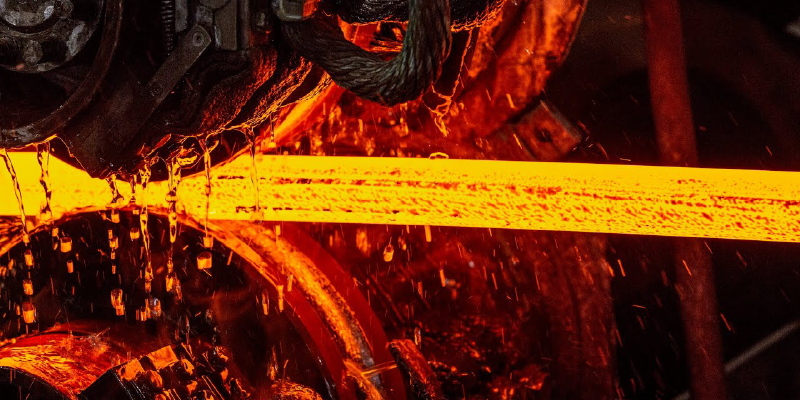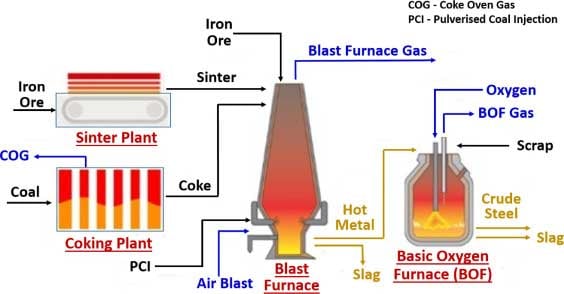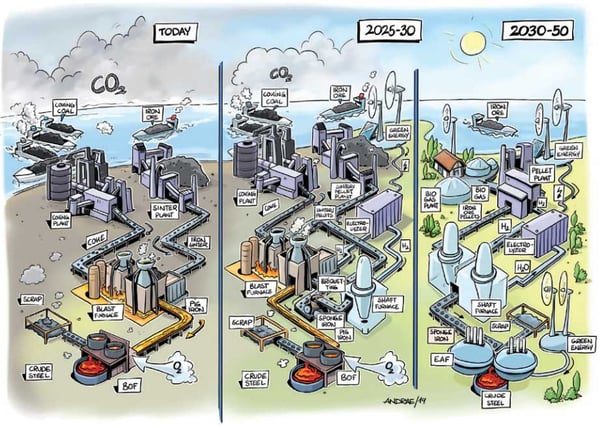If you’re here it’s to learn about the steel process.
But not the classic steel process that is very manual and old-school.
Here you’ll learn about AI and data-driven one.
We’ll go over specific case studies, real-time examples, and even explanatory videos.
This is more of a conversation than a research paper.
There are lots of those out there, our goal is to make it more digestible and easy to understand.
Without further ado, let’s dive in.
Why Steel?
From big rocks to smartphones.
Steel is everywhere.
It's in cars you use to go to work, in homes we build for our families, and in the tiny computers, we carry in our pockets.
Where would we be without steel?
Whether we come from a manufacturing background or any other domain, it's important to understand how steel is made, since it's so ever-present in our lives.
Every era revolved around metal and steel in its own way.
Today technologies and methodologies are currently being innovated to make steel greener and more sustainable. Everything is going green, and steel is no different - something that can be reflected in the manufacturing process.
Now, let's take a look at the visual below, and see the connection between steel and the earth, and the numbers behind extracting ores from the ground (it’s crazy, see Image 1)
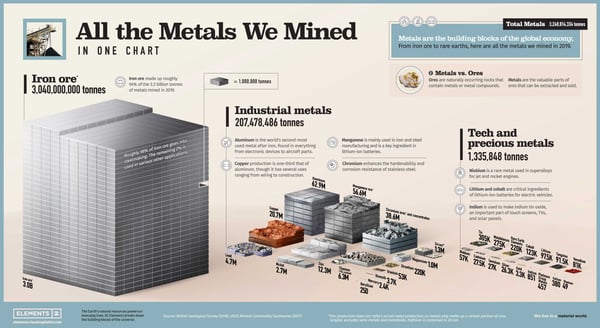 Image 1: All the Metals We Mined. Source: ELEMENTS
Image 1: All the Metals We Mined. Source: ELEMENTS
But steel is an end product, it comes from processing Iron Ore.
The process is much more complex than it seems and it also has other raw materials that help steel have its chemical conditions.
The question would be:
- Where would steel be without iron?
- Where would it be without raw materials - coal, iron ore, limestone, scrap metal, etc.
- What does the process that turns these into steel look like?
- What types of metal are there?
- Where do AI and Data come in?
Metal types can be roughly divided into two main categories::
- Ferrous metals
Those metals that contain Iron, steel being our prime example here. - Non-ferrous
Metals that do not contain iron, like copper, lead, nickel, aluminum, zinc, etc.
In this post, we’ll mainly focus on Ferrous metals, specifically - Steel, how it’s made, and the impact modern tech has on the industry.
Intro to Metal 4.0
Every industry is going through a digital transformation, leveraging new technologies to improve existing business and industry practices. The steel business was one of the first to embrace digital technologies in order to create new possibilities, increase efficiency, enhance quality, and boost profits.
New technology is often accompanied by greater complexity, as well as new and more difficult challenges.
Big data, the Internet of Things, and Artificial Intelligence are vital tools for the new age of technology. They’re relevant not only to eCommerce and other digital companies, but also to businesses that work in furnaces, casting, cold/hot rolling mills, or any other part of the steel production process.
These tools focus on leveraging and maximizing the data you gather from your industrial process.
Some examples of benefits you can expect when using these tools are:
- Centralization and greater control --> monitor all your data and assets in one place
- Automation and the avoidance of repetitive tasks --> easily replicate what works and dedicate more time to what is important.
- Reduce downtime and plan maintenance efficiently--> reduce costs
- Improve productivity and efficiency --> maximize your ROI and profits
- Greater and more consistent quality --> better results, minimized errors, less scrap
These are common benefits, once you get into your process and understand it deeply, you’ll be able to identify another hidden gain that goes beyond the human eye.
The Manufacturing Process - Step By Step
Explaining the steel-making process in detail will help explain the role AI plays (or can play) in making essentially everything easier.
Summed up, it consists of several core steps:
- Iron ore is mined
- The ore is converted into iron proper
- The iron is then processed into steel
- The steel is further molded and processed into the desired final product
This all is accomplished by using a variety of tools and machines, including a blast furnace, an electric arc furnace, ladles, etc. (check out the image 2 for a full overview)
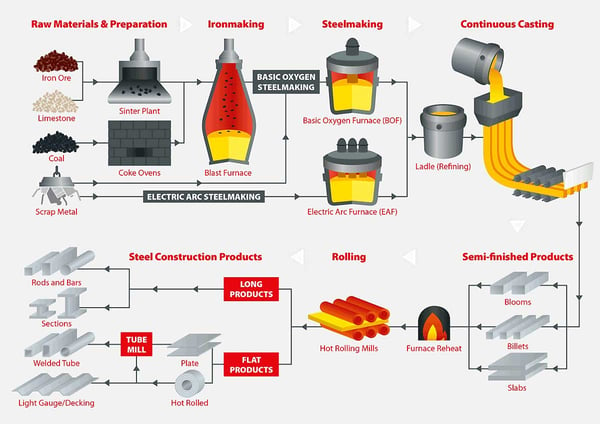 Image 2: Steel Production. Source: vepica
Image 2: Steel Production. Source: vepica
Step 1 - The Road From Iron Ore to Steel
There are several ways we can produce steel in its raw form.
It could be via:
- The Blast Furnace (BF) - Iron Ore + Coal
- DRI + EAF - Iron Ore + Natural Gas
- Electric Arc Furnace (EAF) - Scrap Metal
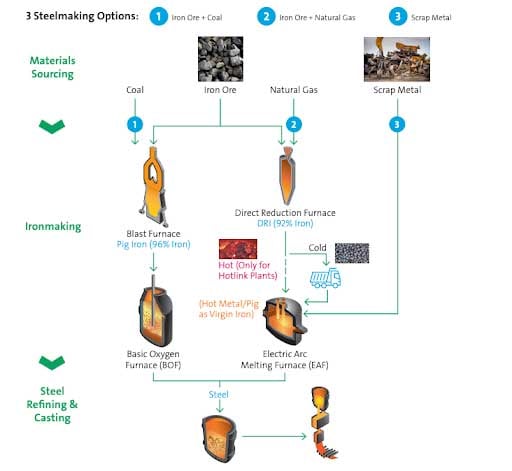 Image 3: Steel Making Options. Source: AirProducts
Image 3: Steel Making Options. Source: AirProducts
1) The Blast Furnace route
The blast furnace route makes up around 80% to 90% of steel production today. It begins with processing iron powder with limestone through a Sinter plant.
That leads to iron ore lumps. This is done because the iron powder would settle down in the blast furnace during the heating process, which disallows proper production.
Iron ore (Fe2O3) is an oxide. In order to be used properly (and converted into pure iron), it has to be processed to remove the oxygen.
In other words, transform Fe2O3 to Fe.
Iron ore lumps and coking coal are burned together in the blast furnace to remove the oxygen and make the Iron.
Additional limestone is added to the cooking process in order to eliminate iron impurities. By this point, the pig iron has been prepared for further processing
This melted iron will go to a ladle and move on to the next part of the manufacturing process (continuous casting e.g.)
In a nutshell:
Iron ore + coke in a blast furnace (BF) = pig iron
Pig iron + Oxygen in a blast oxygen furnace = steel
The entire process can be simplified as follows: the iron ore and the coking coal are combined in a blast furnace, giving us pig iron. Using pig iron and placing it in the BOF generates steel.
This route:
- uses iron ore as raw material
- uses hot air to transform iron ore into hot metal
- has fewer impurities
- requires higher investment and takes more space, making the process overall less efficient
- has high CO2 emissions (some methods such as gas recovery turbines or replacing coke with natural gasses like hydrogen or ammonia may help reduce carbon emissions.
Some challenges that can be tackled today through AI-driven approaches are:
- temperature prediction
- raw material properties tracking
- recommendation for optimal settings and energy consumption
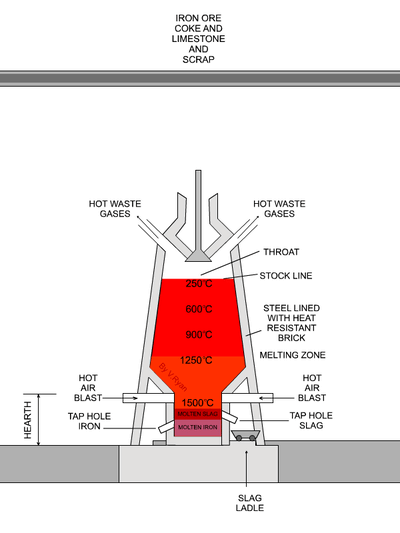 Image4: Blast Furnace. Source: technologystudent
Image4: Blast Furnace. Source: technologystudent
You can learn more about the Chemical reaction that happens inside the Blast furnace here -> https://youtu.be/UjBrZCNVt_s
2) - DRIP (Direct Reduced Iron) + EAF route
Sponge iron is formed through the reduction of iron ore to metallic iron through reaction with coal. It's used in the iron and steel industry as a substitute for scrap to combine with the EAF.
To process the iron ore, you use a DRI rotary kiln.
Fun fact, it’s called Sponge Iron because it literally looks like a sponge. The end product has lots of pores once the oxygen is removed.
In other words, this process is exactly the same as the Blast Furnace process but instead of Coking Coal, Thermal Coal is used to make Iron and then Steel is generated out of Iron using either the BOS or the EAF.
In a nutshell:
(Iron Ore + Natural Gas) DRI + Scrap + electric arc furnace (EAF) = steel
These machines are generally located at steel mini-mills, close to EAF steel plants. The product can be transported hot or cold, meaning you can either finish producing it or sell the raw material to a third party.
This route:
- Is not a scrap substitute but more of a source that can be used to enhance the scrap for the better end quality
- Has a higher Melt consistency
- Ensures that the sponge is free from dust caused during material handling
Some challenges that can be tackled today through AI-driven approaches are:
- energy value prediction and recommendations
- Temperature Prediction
- Quality stability
Image5: DRI Process. Source: Energy and Climate Change, Volume 1
3) The EAF and Scrap metal route
The Electric Arc Furnace begins with scrap metal (or DRI as we saw just before).
Since this metal is already waste iron, it doesn't have to go through a blast furnace and follow the regular iron-making process.
It’s more like recycled metal that is reheated, melted, and processed.
In a nutshell:
Steel Scrap + electric arc furnace (EAF) = steel
The route is much shorter and simpler - the scrap metal is placed into the EAF, processed, and then steel is produced.
This route:
- The source material is mainly scrap --> source of instability, as it's difficult to determine the metal’s properties accurately, which is reflected in the complexity of setting the line
- Uses energy as the main heating source --> high consumption of energy
- Is smaller and more efficient - reduces the time to process the material
- Emits mainly indirect greenhouse gasses, which vary depending on the electricity mix used in the EAF
Some challenges that can be tackled today through AI-driven approaches are:
- Predict quality of steel based on scrap selection
- energy value prediction and recommendations
- Temperature Prediction
 Image 6: Electric Arc Furnace. Source: ScIelo
Image 6: Electric Arc Furnace. Source: ScIelo
Step 2 – From Melted Steel To Steel Slabs
Now that we know how to get melted steel, what happens next? Is this the steel that goes to our fridges and smartphones?
Yes, and no.
It is steel, but it has to go through different other processes beforehand.
The next step of the process is to shape the melted steel into a solid form that can later be worked on.
In steel, you have 2 main lines of product
- Long Products (Rodes/Pipes used in construction)
- Flat Products (Plates/Sheets or Coils of Steel used in making Cars, ACs, Fridge, etc.)
Before getting either one of these two product types (more on this in Part 3), the steel needs to be turned into slabs, blooms, or billets.
This begins with continuous casting.
What is continuous casting?
First, let’s tackle casting.
Casting is a manufacturing process where a liquid material is poured into a mold and then solidified.
Hence, going from liquid steel to solid steel.
Continuous means exactly that.
It’s a continuous (non-stop) process.
When it’s not continuous, it can be a batch process for example.
This means you do a process in a group or batch.
Back to Continuous casting.
Continuous casting has become the dominant process in modern steel production.
You have multiple types of continuous casting.
Vertical, Curved, Strip, Horizontal, etc. There are up to 7 different types (See Image 7), but in this post, we will explain the curved process.
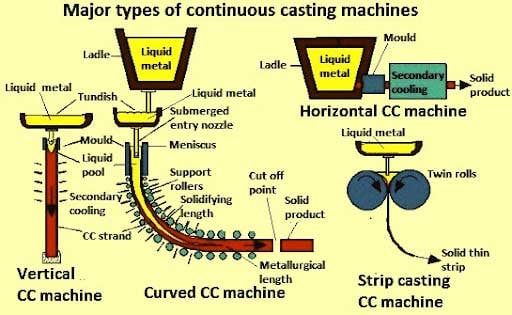 Image 7: Types of Casting. Source: Ispatguru
Image 7: Types of Casting. Source: Ispatguru
Many challenges can arise during this complex process.
Often interventions need to be done suddenly, reactively, producing unexpected stoppages and costly downtime, scrap, and reprocessing.
These issues can lead to substantial expenses for the manufacturer.
The process of curved continuous casting
For example, in the process of curved continuous casting, the liquid steel is transferred via a ladle to the casting machine.
When casting starts, the liquid metal starts to flow at a controlled rate into a tundish and then into a mold.
The mold is then cooled with water and then further down the process it’s cooled again by spraying water (check out Image 8)
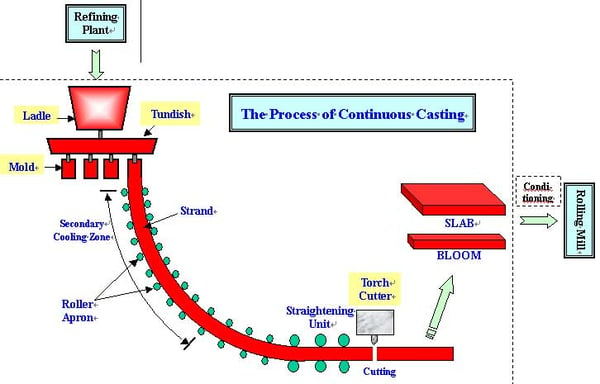 Image 8: Continous Curved Casting. Source: China Steel
Image 8: Continous Curved Casting. Source: China Steel
During the entire processing, the steel is subjected to thermal and mechanical stresses that can easily rise quality problems, such as cracks, shape defects, and the breakout of liquid steel through the solid shell. Kind of like lava in the factory, not a cool thing to happen.
Some causes of cracks can happen due to unbalanced cooling or non-uniform spray configuration.
The majority of this process is automized but having careful control is critical to maintaining a stable and efficient outcome.
Over the last few years, engineers have been leveraging process data and AI to optimize quality, predict failures and increase yield.
Algorithms used by the computer are able to map out more variables than the human brain. These can extract correlations, and find patterns that would be far beyond the realm of possibility for any human.
Here are just a couple of examples of some specific issues that can be improved in daily operation through advanced data analytics:
- Predict gas cutting torches failures
- Focus on the proper cut-through camera vision
- Uneven shrinkage, causing wrong shapes
- Pouring metal defects when the temperature is uneven
Evolving from data governance to ML and artificial intelligence is a must for every industrial manufacturer.
Manufacturers and products will not only get real-time insights but can also empower their engineers with data-driven decisions.
On top of that, the process can be run autonomously, intelligently, and with greater integration with the rest of the production process.
Step 3 - From Slabs to Long or Flat Products
The next step of the process is to process the blooms, billets, and/or slabs that come out of the continuous casting process in order to make a Long or Flat product (see Image 9)
Long products
Long products are generally available in straight lengths barring wire rods which are normally available in irregularly wound coils.
These finished steel products are normally produced by hot rolling of bloom or billets ingots into usable shapes or sizes.
This product segment includes products like bars & rods, steel structurals, and railway materials. Long products are generally used for construction, mechanical engineering, and energy.
Flat products
These are finished steel products that are produced from slabs in rolling mills using flat rolls.
These are supplied in Hot Rolled (HR), Cold Rolled (CR), or in coated condition depending on the requirement.
This product segment involves Galvanised Plain or Galvanised Corrugated (GP/GC) sheets, Hot Rolled (HR) coils or sheets, Cold Rolled (CR) sheets and coils, pipes, and electrical sheets.
Flat products are generally used for automotive and truck wheel frames and body parts, heavy machinery, pipes and tubes, construction, packaging, and appliances.
Basically, the more regular day-to-day things you use come from Flat products.
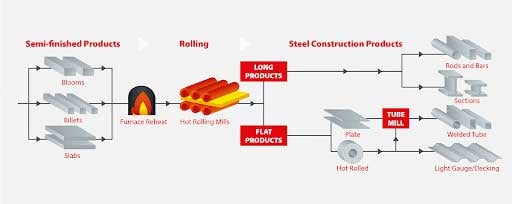 Image 9: Steel Products. Source: NSC
Image 9: Steel Products. Source: NSC
Rolling Mills
To get the too long or flat a product, you need to process the slabs, bloom, and or bills through hot rolling mills.
These are a critical part of the steel production process, supposed to get the steel into the required shape. It is also part of the process where many things can go wrong (I know, every part of the process is critical).
Some possible issues can be:
- Non-homogeneous temperature
- Unstable vibrations
- Speed alterations
- Deviations of rolling force and torque
All of these issues can lead to a lower quality product. Below are two examples of how using data can help prevent these issues:
Example number 1 - Quality – Surface Defects
The challenge: Coils have to be visually inspected for defects, to either be rejected or reprocessed.
The solution: Historical data analysis with ML models to detect defects in real-time. It allows for the study of the connection between manufacturing conditions and defects, leading to an understanding of what exactly is causing specific problems.
The benefits: Detects defects early to address the problem before it escalates. Less reprocessing, less scrap, and happier clients.
Example number 2 - Predictive Maintenance – electric motors
The Challenge: Sudden failures may happen on motors generating unplanned downtime and lowering production output.
The solution: Predict failures and extend the life expectancy of the electrical motors, analyzing and detecting patterns in real-time from consumption, vibration, bearings, etc.
The benefit: Planning efficient maintenance intervention with no unexpected downtime, life expectancy duration increased, smart monitoring, root-cause analysis. You will know what's happening when, where, and why.
Close-looped AI processes are optimized automatically, intelligently, more accurately, and with greater integration with the rest of the industrial machines.
You can check out our DEMO of the Wizata Anomaly Detection Wizard, and see the process in action.
Bonus Part - Energy consumption Reduction
Can Europe's steel industry reach carbon neutrality by 2025? 🤔
There are many technologies out working towards a carbon-neutral steel-making process.
From Carbon Capture use and storage (CCUS) to replacing carbon with Hydrogen with the HYBRIT.
But the truth is that new processes will lead the way, but DATA will allow industrials to focus on gains.
Innovation is a step every industry must take to grow, data shows the way.
Changing a process will help, but understandably deeply your process today and how you can make it more efficient should not be an option. If you know you can do better, what is stopping you?
Check out the full report of Roland Berger, on the future of steelmaking.
Conclusion
Learning how to produce steel from Iron ore, and making it in big quantities catapulted our society to where it is today.
Not only in terms of infrastructure and globalization, but also in technological advancement and intergalactic exploration.
But with all this technology available, it still seems that AI and data are a nice to have instead than a must-have for manufacturers around the world.
I get it, machines are expensive and last many years.
However today you have many alternatives and low-cost entry points to start using AI.
What elements of the steel processing industry can we optimize with AI?
Which of these elements are the most suited for the implementation of the automation processes?
It is our understanding, achieved through research and data analysis, that these elements are furnaces, casting, pumps, compressors, and fan and dust systems!
However, the actual implementation is harder than it seems.
In order to efficiently implement the AI and automation solutions, we will need a concise and well-thought-out plan.
With that said, your plan of implementation will have to account for all possible variables, such as selecting superior raw materials, modernizing equipment, and the latest techniques in order to finally pave the way for advanced analytics, AI, machine learning, and automation.
Considering the benefits of advanced analytics, here are some of the things we will be able to do:
- Define the right settings for a particular line. More closely, determine precisely the optimal mix of air and fuel for maximum efficiency of our furnaces.
- Track and analyze raw data for raw materials used in smelting and mixing to determine the proper mix for max quality steel.
- Automate the production process, and optimize it to remove any inefficiencies, as well as predict downtimes and maintenance, all in order to keep up with our clients’ deadlines.
- Optimize temperature distribution in order to avoid potential breakdowns and reduce pressure on the whole system.
With that, it is easy to realize that automation and AI learning are the way of the future for the metal processing industry.
These new technologies will not only improve our own ROI, but they will also have a positive effect on the environment.
Testimonials
"Wizata's Data Explorer tool has helped my company streamline data management to improve overall efficiency. The platform allows easy data management from multiple sources using one highly visual dashboard. I found it extremely useful when it comes to navigation and rapid data analytics. The AI is able to predict future trends and identify weak spots in the operation much faster than anyone expected."
Wizata Case Study/ Real-life Example
Data-driven predictive maintenance for continuous casting optimization
A long-product metal producer wants to reduce costs by avoiding production stoppages and efficient maintenance. The client decides to focus on the continuous casting section as it's the most challenging production process. The scope of the mission is to apply artificial intelligence technologies to predict failures and plan maintenance on 4 cutting torches.
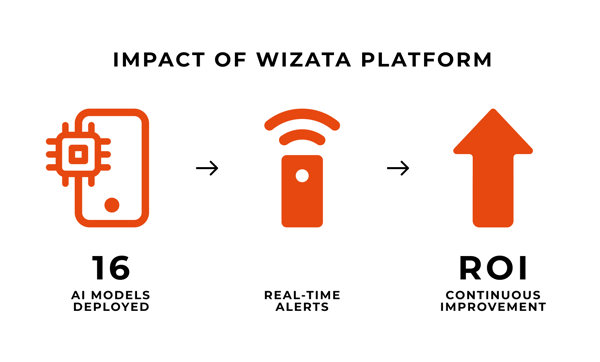
Challenge
Cutting torches failures are particularly costly and hard to predict due to the unstable nature of the process. High temperature and speed of the process pose challenges to maintain the environment under control and react promptly to any exceptions and deviations.
The client has so far relied on the experience of their operational experts to predict failures. But has since expressed interest in digitalization and automatized detection of critical events.
Solution
During the mission, 4 main root causes have been identified as the ones generating more failures and bringing the highest cost/ benefit ratio.
- Overall, 76 models are deployed through the Wizata Platform, working in real-time and triggering prediction.
- The system’s improved stability saves time for the operational team, improving their efficiency as they can anticipate and adapt planning regarding malfunctions, rather than having to deal with emergencies.
- The solution is ready to be replicated and integrated into other plants with little adaptation, leveraging on the combined previous work done by the two teams.
Result
The success of this mission allows the company to predict upcoming failures, thus avoiding useless downtime, cutting maintenance costs, and avoiding a decrease in production rate.
- 4 strands are connected in real-time to the Wizata platform.
- Operators receive direct notification in their inbox and through SMS, alerting them when a deviation and a possible failure are about to happen. This allows them to monitor the situation and take corresponding actions to avoid stoppage or last-minute intervention.
- Engineers monitor the environment through the Wizata Platform, being able to transform and analyze their data into insights.
KPIs set up at the beginning of the mission have been met successfully, and a solid ROI has been generated since day 1 of the deployment.


